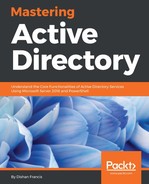Apart from the computers, AD supports other devices and objects types as well. In this section, we will look into these different object types:
- Printers: Printers are one of the most commonly shared resources in an office network. We can use several methods to configure shared printers in user computers. We can set them up using the printer setup wizard in Windows and connect to a printer via an IP Address. We also can use log on scripts to map and install printers in workstations. If an organization uses printer servers, we can connect to it and install the printers too. In the AD environment, we can register the printer as an object in AD. It will allow the users to browse the AD and find the relevant printer quickly, without going through different printer servers.
This can be integrated with a directory from the printer properties. To register a printer with AD, go to Printer properties and then to the Sharing tab. There you can put tick on the List in the directory checkbox to list it on AD:

Then in workstation, we need to select the option to list printers from the directory during the printer setup process. It will list down the AD integrated printers:

- inetOrgPerson: This object is defined in RFC 2798. This object type is used by other directory services which are based on LDAP and X.500. This is existing in AD in order to support migration from non-Microsoft directory service and support applications that requires inetOrgPerson objects. This object can be converted into regular a AD user.
In order to add this object, we can use ADAC, ADUC, or PowerShell.
In PowerShell, it will be using the same cmdlet New-ADUser, which will be used to add a regular AD user:
New-ADUser -Name "Inet User1" -GivenName "Inet"
-Surname "User1" -SamAccountName "inetuser1"
-UserPrincipalName "[email protected]"
-AccountPassword (Read-Host -AsSecureString
"Type Password for User")
-Enabled $true -Path "OU=Users,OU=Europe,DC=rebeladmin,DC=com"
–Type iNetOrgPerson
The preceding command will add an inetOrgPerson object called Inet User1. The only difference in the command from a regular AD user is –Type iNetOrgPerson, which defines the account type as iNetOrgPerson.
We can convert the inetOrgPerson object to a regular AD user object using the following command:
Set-ADUser "inetuser1" -Remove @{objectClass='inetOrgPerson'}
The following screenshot shows the output for the preceding command:

